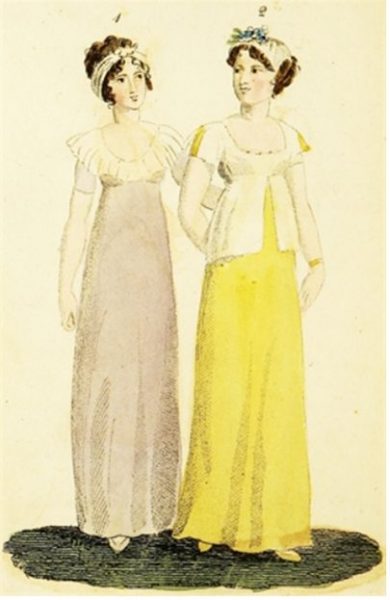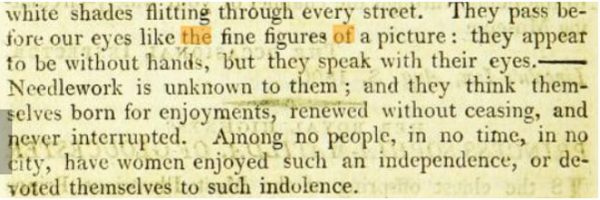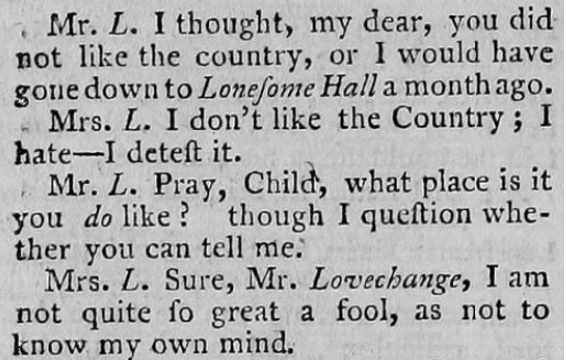I assisted Dr. Ann Little with her research during the Spring semester of 2021. The internship was focused on publications and magazines in the AAS Historical Periodicals Collection Series 1 archive from the CSU Library regarding the emergence of the empire-waisted dress (Image 1) in women’s fashion, why it appeared in the late 18th century and disappeared in the early 19th century, and what changes it occurred.

The empire-waisted dress is interesting because it was a very liberating style for women, as ideas of showcasing the natural body appeared in fashion, that was around the turn of the nineteenth century; as Amelia Rauser points out in The Age of Undress, this was not a sudden change in taste among women but rather a “wholesale transformation of the aesthetic concerns of the moment and their intersection with women’s cultural position in particular.” The style had fewer layers and support, except for the occasional short stay, like a bralette, built into the dress; the waist was brought up just under the bust, emphasizing the breasts, and had a columnar skirt that starkly contrasted with other fashions of the time that shaped and supported a woman’s body through corsets and hoop skirts. I researched in English-language magazines from 1775-1815 that provided contradictory advice and critiques about what a woman’s fashion and character should be.
In “Manners of the Parisian Ladies” (1800), women were criticized for being immodest in both fashion and character, especially when wearing the empire-waist dress (Image 2). The author exclaimed that “[t]wenty years ago young women would not have stirred a step from home without their mothers: they walked, as it were, under their wings; their eyes modestly thrown upon the ground. The man whom they dared to look at was the one whom they permitted to hope or chuse for a husband. Now they run about, morning and evening, in full liberty – to dress, to walk, play, laugh, draw cards, dispute about their adorers” meaning that such loose clothing had made women behave more liberally. This conveys the idea that fashion reflected the character and behavior of young women and, according to some, adopting such ‘transparent’ fashions led to immodest women.

Similarly, in Mirror of the Graces (1813) the author commented on how Grecian styles led to the emergence of immodesty where women were “unveiling the too redundant bosom”. The author then endorsed the empire-waisted dress, but condemned people who wore too much of the Greek and Roman fashion, “mingled confusedly”. This demonstrates the contradictory advice that was given to women regarding fashion as they were encouraged to adopt the Grecian fashion, yet at the same time were deemed inappropriate for wearing “too much” of the style or revealing too much skin.
This kind of contradictory advice is also seen regarding character; in “Reflections on the Education of Young Women” (1801), women were advised to be generally cautious or prudent yet at the same time (within the same magazine) were recommended “to be taught never to rely upon their prudence.” Women were also displayed in magazines as fickle beings who should focus on the domestic sphere as seen in “Dialogue Xix. A Conjugal Tete-a-Tete” (1776) where a couple argue over whether to go on vacation (Image 3). Mrs. L wishes go shopping to look in style while socializing on vacation; Mr. L remarks that he won’t be able to afford both; Mrs. L then responds that she is unwell and her Doctor has recommended that she travel to the sea. Mr. L remarks that women would not be ill or bored as Mrs. L is “if they lived in a regular manner, and filled up their time both usefully and agreeably in looking after their families, nursing and instructing their children”. In this publication, women are being encouraged to stay at home where they would be less bored and wouldn’t need to socialize or spend money on clothing at all.

Through my research with Dr. Little, I have been able to explore the contradictory advice women were being given regarding their dress and character in the eighteenth and nineteenth centuries in Britain and the U.S. This advice affected their engagement with the social and political world regarding social visibility and increased behavior changes among women which seems to have continued into modern times regarding today’s fashion magazines.
